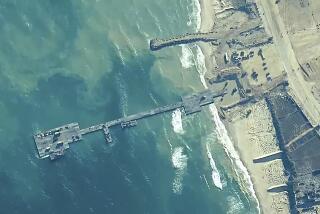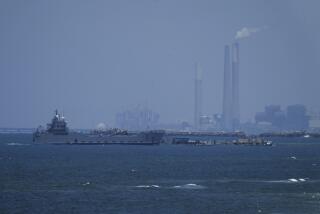Challenges Await Troops in Inland Town Gripped by Famine : Somalia: Bardera sits where two heavily mined roads meet. And it has a full share of deadly armed bands.
- Share via
BARDERA, Somalia — In this remote town far beyond the front lines of Operation Restore Hope, Osman Dial Mohamed used a tree branch Sunday to stir giant vats of rice and beans for Somalis waiting anxiously for American troops to deliver them from starvation.
Several thousand hungry Somali women and children crowded around him at the Red Cross feeding center here shouting “Osman!” “Osman!” as Mohamed scooped food into their buckets, teapots, cooking oil cans and baskets.
He paused occasionally to wipe sweat from his brow or raise his ladle and threaten the unruly crowd. A vulture circled in the sky above.
This remote town in the grip of famine, which records 70 deaths daily from hunger, will within days present American and foreign forces with their most challenging and dangerous mission since they arrived in Somalia 12 days ago.
Bardera sits at the junction of two heavily mined roads, one leading 300 miles to the port in Mogadishu, the other 160 miles to the port in Kismayu. There are no paved roads here, and the packed-dirt airfield, tended daily by 40 Somalis employed by a relief agency, is useless when it rains.
Residents of Bardera, from the shoppers at the market downtown to the ragtag group of Somali soldiers lounging near the Juba River on the outskirts of town, said Sunday that they hope the imminent arrival of U.S. troops will end their long suffering and isolation.
“We need them so much to bring peace,” said Habiba Aden Ali, a 63-year-old woman selling tiny tomatoes and limes in the market. “They are too late, but we will be very happy to see them.”
Ebrahim Ahmed Mohamed, a 25-year-old soldier in the factional army that controls Bardera, added: “We want them to help us send the refugees back to their homes. We want these Americans here.”
As he spoke, he was surrounded by men carrying antitank missiles and machine guns. Belts of bullets wrapped around their shoulders and waists clicked like castanets when they walked. Rusting carcasses of Soviet tanks and trucks sat nearby.
It’s no wonder that so many in Bardera are hoping to be rescued. A week ago, Sheik Musah, a beloved Islamic religious leader in this town of 60,000, was shot to death in his home. It looked like robbery, but townspeople think it was the work of fundamentalist Muslims from a nearby town who were angry that the holy man had not condemned American intervention in Somalia.
In recent days, a land mine expert hired by the relief agency CARE has unearthed 13 antitank mines. A 14th destroyed one of CARE’s 10-ton trucks loaded with relief food for the hinterlands.
The streets in town aren’t safe either. Relief trucks have been hijacked. And CARE, the largest aid agency operating here, spends $10,000 a month on security for its relief food and supplies--all of which must arrive by air.
“We’re hostage to the situation,” said David Stables, CARE’s director here. “And you always have to make sure that the guns guarding you are not the guns that will be turned on you. These people have had nothing for years. And they’ve learned how to get what they want by the gun.”
Amid the increasing violence, more than 40,000 people being fed by relief agencies are afraid to return to their rural homes, where good rains have raised the possibility, for the first time in more than a year, of a decent harvest in February.
“Our first job, once the American troops come, will be to stop the dying,” Stables said. He added that the foreign forces will allow relief agencies to stockpile food, which they avoid now because of fears of looting. It also will allow aid groups to feed people in the countryside, nearer their homes, and reduce the growing refugee population in Bardera.
Operation Restore Hope, which reached another milestone Sunday with the seizure of the port city of Kismayu, is expected to bring troops to this famine capital soon.
But they will face a difficult task, with the mined roads, the dirt airstrip and a road from the airport that is impassable, even by military vehicles, when wet. Until the mines are cleared, the multinational force will be forced to rely on the airport to bring in troops and supplies. And American military commanders have said Bardera presents them with greater logistics difficulties than any other planned operation in Somalia.
U.S. officials, though, have begun preparing the community here for the troops’ arrival. A team of State Department officials was locked in meetings Sunday with town elders, who generally welcome the American arrival because they believe the troops will restore security to the streets, rid the roads of land mines and perhaps rebuild roads, bridges and other infrastructure devastated by the 2-year-old civil war.
The famine in Bardera has eased in recent weeks, relief officials say. But the people are highly susceptible to disease and the armed bands that prey on them. Two months ago, in a bloody series of battles, Gen. Ahmed Warsame drove forces loyal to Gen. Mohammed Farah Aidid, the country’s main warlord, from the city. Relief officials also fled.
In the five days that relief agencies were gone, the death toll from the famine rose from 100 a day to 300 a day. Now it is less than 100 a day, and aid officials say that can be cut further when the countryside becomes safe for relief operations.
American officials have won support for Operation Restore Hope from Warsame. He has not agreed to surrender his weapons, but he says he might consider doing that in the future.
“We will cooperate with the American troops and American officers to get food and supplies to our village,” Warsame said Sunday. However, the thin, bearded general, flanked by guards armed with machine guns, added that the residents still need his 3,000-man army to protect them.
Bardera has been a main battleground in the factional warfare that has plagued Somalia since President Mohamed Siad Barre was ousted last year. The revolutionary troops then split, mostly along clan and sub-clan lines, and the fighting continued. Bardera is home to at least 25 sub-clans.
Warsame and his forces do not have complete control of the guns in Bardera. Armed gangs frequently pillage what little is left in this bombed-out town.
But American officials and relief agencies think the looters will disappear in the face of a massive U.S.-led military presence.
“These men with guns who are beyond the law will just melt away,” Stables predicted. “And then we will be able to get food to the people who need it.”
More to Read
Sign up for Essential California
The most important California stories and recommendations in your inbox every morning.
You may occasionally receive promotional content from the Los Angeles Times.














